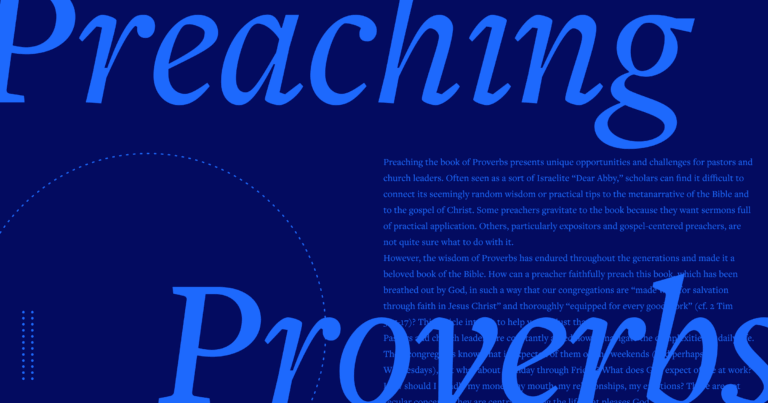
It might seem strange—and even boring—to name a Christian denomination after a system of church government, but that is exactly what we have in Presbyterianism. Besides, the Episcopalians have done the same thing!
As a matter of fact, setting Presbyterianism beside Episcopalianism makes for an interesting contrast. Both groups are Protestant. Both have roots in the Reformation era (16th–17th cents.). And both have a common English/Scottish ancestry. The difference, however, can be found in the etymology of their Greek-derived names. Presbyterianism comes from the New Testament Greek word meaning “elder” (πρεσβύτερος), and Episcopalianism comes from the Greek word meaning “bishop” or “overseer” (ἐπίσκοπος).
So then, by definition, Presbyterian churches are those that are led and governed by a plurality of elders, who together comprise the session or the consistory of the church. These elders are often sub-categorized as ruling elders and teaching elders, the latter of which are usually known simply as pastors. Each local congregation, therefore, has a team of elders who lead and direct the church.
Importantly, local churches often cooperate in associations of geographically proximate churches called presbyteries. By contrast, traditional Episcopalian churches are directed by a singular bishop who has directive authority over a similarly geographic region of churches.
In the following article, we will discuss the biblical foundations, history, theology, and key practices of Presbyterian churches.
Table of contents
The Bible’s foundations for Presbyterian polity
Presbyterian churches assert that our system of church government deeply aligns with Scripture.
Going back to the Old Testament, Moses’s father-in-law, Jethro, instructed him to share his administrative authority with elders (Exod 18:1–26). And while Israel had been led at various times by judges, kings, prophets, and even warriors, the respect and esteem of tribal elders was intrinsic to her body politic.
In the New Testament, we see the Presbyterian system emerge organically out of Paul’s three missions to plant churches (Acts 13–21). Paul seems to have insisted that each local church be governed by a plurality of elders, as he personally ensured that the churches he founded be supplied by such godly and competent men (see a key text: Acts 14:23). As Paul delegated leadership to men like Timothy and Titus, he specifically instructed them to safeguard the authority of the local church to elders who were both faithful and able to lead (1 Tim 3:1–7; Titus 1:5–16).
Presbyterians are quick to point out that the terms “elders” and “bishops” used in the New Testament are synonymous, that is, used interchangeably (cf. Titus 1:5 and 7). Moreover, Presbyterians have usually viewed the office of deacon as distinct from the elders, with deacons holding a position of humble servanthood to care for the more practical matters of the church (Acts 6:1–6).

Acts 20, Titus 1, and 1 Peter 5 use elder, overseer, and pastor interchangeably
While many modern churches hold a congregational form of government, recognizing the independence of local churches, Presbyterians have instead emphasized that our churches are to be connected in an organic and vibrant mutuality. Thus, Presbyterians point to the churches of the New Testament as sharing and receiving funding, ministers, letters, council, and other resources (Col 4:7–18; 2 Cor 9:1–5). For this reason, Presbyterian churches associate openly with proximate churches of like-minded conviction, meeting regularly for prayer, fellowship, ordination, and shared ministry or mission endeavors.
In a quintessential example of church cooperation, Presbyterians point out the Jerusalem Council of Acts 15 as a stellar moment in which the New Testament church:
- faced a problem (Acts 15:1),
- sent delegates (15:2),
- discussed the matter (15:6–11),
- consulted Scripture (15:13–17),
- came to a shared conclusion (15:19–21), and
- acted cooperatively (15:22–35).
Thus, Presbyterians have held that holding larger synods or general assembly gatherings, as necessary, is good and right for the church at large.

A brief history of Presbyterianism
The Protestant manifestation of Presbyterian churches began to coalesce at the time of the Reformation under the instruction of several important theologians, including John Calvin (1509–1564) and John Knox (1514–1572).
From John Calvin to John Knox
Calvin, whose theology became definitive for the Swiss, Dutch, Belgic, and English Puritan churches, served as an invaluable Bible exegete and systematic theologian. His commentaries and his magisterial The Institutes of the Christian Religion are considered leading works in Reformation theology and biblical study.
However, it was his some-time student John Knox who was instrumental in the establishment of a truly Presbyterian system of church government (or polity) in Scotland. Knox’s efforts to bring the light and fire of Reformation preaching to Scotland is viewed as a high-watermark in the development of a distinctly Presbyterian ecclesiology. Here, we see the advent of what would become a hallmark arrangement of Presbyterian church government: local sessions, regional presbyteries, and larger, less frequent, and general assembly meetings.
The Covenanter movement
Knox’s efforts would not go unchallenged, however. As national and international politics changed over the years—complicated by ever-changing monarchs across the kingdoms of England, Scotland, and Ireland—certain kings attempted to usurp the power of the presbyteries by foisting their own prerogatives upon the church. These efforts resulted in Erastianism (the direct rule of kings over the church) or prelacy (the indirect rule of kings over the church, through regional bishops, who ostensibly did the king’s bidding).
Scottish efforts to resist Erastianism and prelacy resulted in the emergence of the Covenanter movement, which steadfastly resisted such tyrannical overreach at the cost of persecution and martyrdom, especially in the “Killing Times” of the 1680s. The Covenanter movement is still revered as one of the most zealous and ardent, if uncompromising, branches of the Presbyterian family tree.
Presbyterianism in America
In America, Presbyterians came to the colonies early (1640s) and remained faithfully vibrant during the eventual founding of the nation in 1776. The first presbytery was founded in America as early as 1706, and by 1789 the first general assembly had been established.
The Presbyterian movement was seen as an ideological impetus to the Revolutionary War, with many of our clergymen serving as chaplains or even soldiers. This association was probably strong due to Presbyterianism’s built-in resistance to kingly overreach (recall: Erastianism and prelacy above). To this end, the Revolutionary War was often dubbed the “Presbyterian Revolt.”
Presbyterianism grew quickly across the colonies, especially through the immigration of thousands of Scotch-Irish settlers who brought their religious convictions with them to the New World. Yet growth was not entirely unchallenged. Two major splits and reunions ensued following on the heels of the 1740–42 Great Awakening (over revivalism) and the 1861–65 Civil War (over states’ rights, slavery, and outright war).
Presbyterian theology & practice
Theologically, Presbyterianism traditionally holds to the system known as Reformed theology. Reformed theology developed in parallel to, but often distinct from, Lutheran theology as a by-product of the Reformation moment of the early-to-mid-1500s. Often, the distinction fell along geographical and linguistic lines, with Lutheranism tracing contours of Luther’s thought in Germany, while Reformed theology developed in consensus with Calvin, Ulrich Zwingli, Martin Bucer, Heinrich Bullinger, and Johannes Oecolempadius on the continent; and in concert with John Knox, William Perkins, and the emerging Puritan movement across the Channel.
For better or for worse, however, it was John Calvin’s name that stuck, and the towering Frenchman’s influence has loomed large over Presbyterianism since its inception. Thus, Presbyterians are quintessentially “Calvinistic” in name and essence.
Emphases in Presbyterian theology include:
- A fully orthodox and creedal understanding of God in his trinitarian glory
- A high esteem for the Holy Scriptures alongside an ardent desire to extoll both God’s Law and gospel
- A reverent view of the sacraments of baptism and the Lord’s Supper
- The proclamation of salvation by grace through faith alone (in general alignment with Luther’s articulation of justification)
- A zeal for the furtherance and edification of church, state, family, and vocation

Sort your resources in Logos by denominations like Presbyterian.
Presbyterian confessionalism
Historically, Presbyterians have been keen to write new statements of faith, called confessions. This practice shares some commonality with Lutheranism and Anglicanism, as well. Confessions tend to be much longer than the ancient, historic creeds, and are more all-encompassing. Presbyterians have esteemed several such iterations of regional or national confessions, including the Scots Confession, Swiss Confessions, the Heidelberg Catechism, and the Synod of Dort. However, there is no doubt that the most important confession to the Presbyterian tradition is the Westminster Confession of Faith (1646), along with its Larger and Shorter Catechisms (1647).
Written at the time of the English Civil War (1640s), the Westminster Assembly was called by the Long Parliament in order to help unify the Three Kingdoms (England, Scotland, and Ireland) in doctrine and fortify their Protestant interests. Meeting over the course of several years, 120 “divines” (pastors, theologians, and landowners) met to help lead the church through this period of tremendous uncertainty and bloodshed. Eventually, the thirty-three chapters of the Confession were written, along with proof texts, catechisms, and a directory of public worship. Scotland, bound to England by the Solemn League and Covenant (1643), likewise approved the Confession for her churches. Ironically, at the time of the Restoration (1660), England reverted back to her Anglican ways and doctrine, while Scotland retained the Westminster Confession, becoming its champion for the centuries to come.
Today, most Scotch-influenced Presbyterians and their respective denominations formally subscribe to the Westminster Confession of Faith and Catechisms, although Dutch Reformed churches (very similar in doctrine and ethos) subscribe to the Three Forms of Unity, consisting of the Belgic Confession, the Synod of Dort, and the Heidelberg Catechism.
Although undoubtedly anachronistic, Presbyterianism certainly holds to the so-called “Five Solas” as well as to the T.U.L.I.P. doctrines, commonly associated with Calvinism. These two schemas are modern simplifications of our doctrine, but they can nevertheless be helpful in certain didactic ways, especially in introducing neophytes to Presbyterian life and theology.
Presbyterian worship
Presbyterian worship is usually safeguarded by the so-called regulative principle of worship, in which worship is restricted to only those elements that are specifically commanded in Scripture. Thus, services are filled with elements such as prayer, reading of Scripture, confession of sin, giving of tithes and offerings, singing of “psalms, hymns, and spiritual songs” (Col 3:16), and the celebration of the Lord’s Supper and baptism.
Presbyterian churches are usually built beautifully and stately, but free from ornamentation such as images of Christ, which are considered to be violations of the Second Commandment (see WLC 109).
Presbyterians emphasize the “ordinary means of grace,” which are the preaching of the Word, celebration of the sacraments, and prayer.
Presbyterian covenantalism
Because Presbyterians practice infant baptism, they consider themselves to be “covenantal,” meaning that they value not just the individualistic experience of religion, but the whole Christian family walking together in faithfulness. Thus, it is common for Presbyterians to stress personal devotion, family worship times, the catechism of our children, and the family observance of the Sabbath or “the Lord’s Day.”
Presbyterian missions & evangelism
Presbyterians expect that the world will be “filled with the knowledge of the Lord as the waters cover the sea” (Hab 2:15), and therefore send missionaries and church planters all over the globe. Besides the Americas, Presbyterianism has a stronghold in several countries in Africa, and most notably South Korea, where Presbyterian missionaries have been highly successful. Presbyterians have often stressed evangelism to the Jews, with both the Westminster Directory of Public Worship and the Larger Catechism no. 191 extolling pastors and members to pray for their conversion regularly.
Modern Presbyterian denominations
Today, the mainline branch of Presbyterianism, founded in 1706, still exists in America, though demographic studies suggest that it is dying quickly. The mainline PC(USA) is the result of several splits and mergers, but has fallen into massive decline in the last century, arguably due to an influx of secularism, liberalism, and progressivism. Many of its churches have departed from traditional understandings of marriage and sexuality.
That notwithstanding, modern Covenanters, though perhaps much smaller and fewer, are often vibrant and strong, still holding to the essential theology of Westminster. The ARP and RPCNA are both related to the Covenanter movement.
Perhaps the most vibrant and energetic expressions of the Presbyterian movement today, at least in America, are found in churches that have had to leave the mainline church, forsaking their property. The PCA is the largest and most robust of these conservative churches. The PCA is energetically evangelical and faithfully confessional. So too the older, smaller, and somewhat more regionalized OPC. Indeed, several faithful movements of conservative Presbyterian denominations are loosely affiliated in the association known as NAPARC, in which membership is reserved for those denominations that retain a high regard for Westminster.
Prominent figures in Presbyterianism
Presbyterianism has bequeathed to the world the gift of many excellent and competent theologians besides those already named. Among more recent notables are:
- Charles Hodge
- B. B. Warfield
- Cornelius Van Til
- J. Gresham Machen
- John Murray
- Francis Schaeffer
- Greg Bahnsen
- R. C. Sproul
- John Frame
And many others.
Conclusion
Presbyterianism has a long and storied history at the very center of Protestant Christianity. Along with the Anglican and Lutheran branches of Protestantism, the Reformed churches in general and the Presbyterian church in particular have maintained an important role not only in Europe and America, but on the Korean Peninsula, Africa, and around the world. Presbyterianism has contributed positively to global missions, revivalism, theological research and writing, and social concern for the poor, neglected, and marginalized. Its focus on doctrinal fidelity, confessional identity, and reverent worship has made it a marvelous home for millions of believers around the world.
Matthew Everhard’s recommended resources on Presbyterianism
- Sean Michael Lucas, On Being Presbyterian: Our Beliefs, Practices, and Stories
Seeking a Better Country: 300 Years of American Presbyterianism
Save $13.00 (46%)
Price: $14.99
-->Regular price: $14.99
Westminster Confession of Faith | WCF (including the Larger and Shorter Catechisms, American Revision, 3 vols.)
Save $0.90 (5%)
Price: $17.09
-->Regular price: $17.99
Institutes of the Christian Religion (2 vols.)
Save $18.00 (45%)
Price: $21.99
-->Regular price: $39.99
What Is Reformed Theology?: Understanding the Basics
Price: $16.99
-->Regular price: $16.99
Additional resources on Presbyterianism and Reformed theology
The Practical Calvinist: An Introduction to the Presbyterian & Reformed Heritage
Save $8.40 (35%)
Price: $15.59
-->Regular price: $23.99
Presbyterianism (Blessings of the Faith)
Save $3.00 (18%)
Price: $12.99
-->Regular price: $12.99
Reformed Covenant Theology: A Systematic Introduction
Save $13.50 (30%)
Price: $31.49
-->Regular price: $44.99
For a Continuing Church: The Roots of the Presbyterian Church in America
Save $0.60 (5%)
Price: $11.39
-->Regular price: $11.99
Presbyterian and Reformed Churches: A Global History
Save $11.20 (35%)
Price: $20.79
-->Regular price: $31.99

 4 weeks ago
44
4 weeks ago
44










 English (US) ·
English (US) ·